
Curoba is a monotypic moth genus in the subfamily Arctiinae erected by Francis Walker in 1865. It contains the single species Curoba sangarida, first described by Caspar Stoll in 1782, which is found in southern India and Sri Lanka.

Ceretes thais is a moth in the Castniidae family. It is found in Brazil. Superficially it looks very like a butterfly, and was originally placed by Dru Drury in the "Papilio " group which mostly corresponds with modern Nymphalidae.
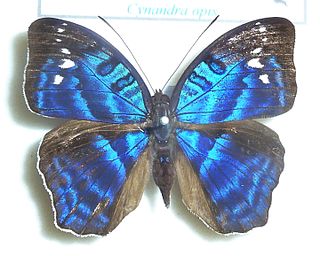
Cynandra opis, the brilliant nymph, is a butterfly in the family Nymphalidae. It is the only species in the monotypic genus Cynandra. It is found in Guinea, Sierra Leone, Liberia, Ivory Coast, Ghana, Togo, Nigeria, Cameroon, Gabon, the Republic of the Congo, the Central African Republic, Angola, the Democratic Republic of the Congo, Uganda and Tanzania. The habitat consists of dense forests.
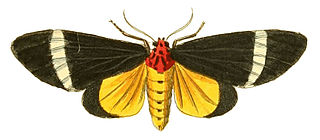
Caryatis phileta is a moth of the subfamily Arctiinae. It was described by Dru Drury in 1782. It is found in Cameroon, the Democratic Republic of the Congo, Gabon, Ghana, Nigeria and Sierra Leone.

Colla rhodope is a moth in the family Bombycidae. It was described by Dru Drury in 1782. It is found from Mexico to Colombia, Ecuador and Brazil.

Crameria is a monotypic moth genus in the family Noctuidae erected by Jacob Hübner in 1819. Its only species, Crameria amabilis, was first described by Dru Drury in 1773.

Letis hercyna is a species of moth in the family Erebidae. It was first described by Dru Drury in 1773 from Jamaica.

Gaeana maculata is the type species of cicadas in the genus Gaeana. It was first described by Dru Drury in 1773, from China.

Otroeda cafra is a species of moth in the tussock-moth subfamily Lymantriinae. It was first described by Dru Drury in 1782 from Sierra Leone, and is also found in Cameroon, DR Congo, Malawi, and Nigeria.

Otroeda nerina is a species of moth in the tussock-moth subfamily Lymantriinae. It was first described by Dru Drury in 1782 from Sierra Leone, and is also found in Cameroon, DR Congo, Gabon, Ghana and Nigeria.
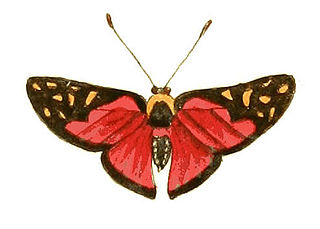
Symmachia menetas is a species in the butterfly family Riodinidae found in Brazil and Suriname. It was first described by Dru Drury in 1782.

Anteros acheus is a species of butterfly of the family Riodinidae, found in Brazil, Suriname and Bolivia. It was first described by Caspar Stoll in 1781.

Pseudobunaea alinda is a species of very large moths in the family Saturniidae. The species was first described by Dru Drury in 1782, and is found in Angola, Cameroon, Congo, DR Congo, Gabon, Guinea, Ivory Coast, Sierra Leone, and Tanzania.

Melinoessa fulvescens is a species of moth in the family Geometridae, native to Sierra Leone and Gambia. It was described by Dru Drury in 1782 as Phalaena fulvata, a name which was pre-occupied. The current, slightly different, specific name was given by L. B. Prout in 1916.

Zamarada eucharis is a species of moth in the family Geometridae. It was first described by Dru Drury in 1782, from Sierra Leone. It is found in Ivory Coast, Ghana, Guinea, Liberia and Sierra Leone

Lobobunaea phaedusa is a species of very large moths in the family Saturniidae. It is found in much of sub-saharan Africa, where its host plants include African custard-apple, crown-berry, and Aframomum spp.
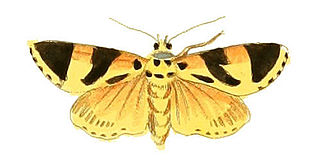
Attatha ino is a species of moth of the family Noctuidae. It was described by Dru Drury in 1782 from "Madras".
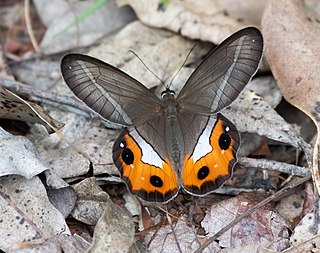
Pierella nereis is a butterfly species from the subfamily Satyrinae in the family Nymphalidae. It was first described by Dru Drury in 1782 from Brazil.
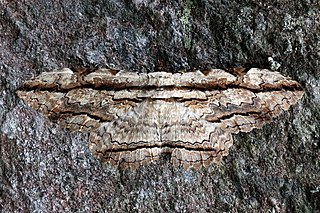
Thysania zenobia, the owl moth, is a species of moth in the family Erebidae. The species was first described by Pieter Cramer in 1776, and is native to North and South America and the Caribbean.

Lyssa patroclus is a species of moth in the family Uraniidae. The species was described by Carl Linnaeus in his 1758 10th edition of Systema Naturae from the Moluccas.





















